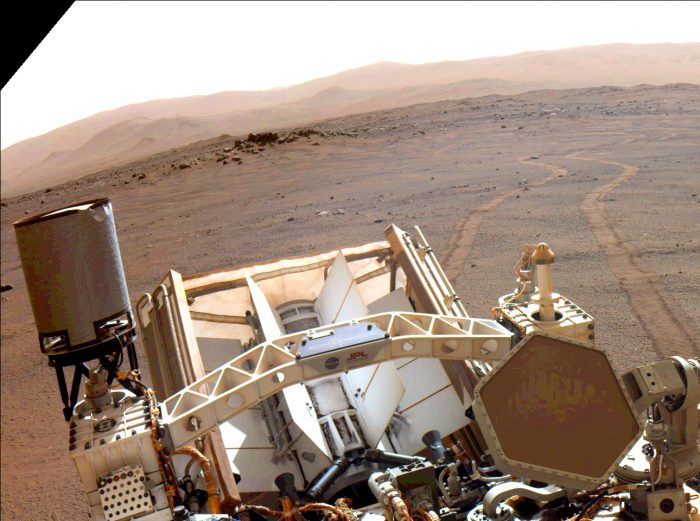On February 18 2021, the Perseverance rover landed on Mars. And its cameras have finally spotted the parachute that got it safely to the planet’s surface!
The parachute was photographed by Perseverance's MastCam-z on April 6, or Sol 404. (A sol is what scientists call a day on Mars—this is the 404th 'day' of the Perseverance mission).
Finders keepers!
The rover dropped the parachute before landing so it could be lowered down to the surface on wheels safely. Perseverance landed in the Jezero Crater—a crater on Mars that scientists believe was once filled with water.
The parachute fell fairly close to the crater. But Perseverance (like all Mars rovers) is a slow mover. Its top speed is just 152 meters per hour (0.09 mph)—a car going down a quiet neighbourhood street travels that far in about 15 seconds! But after over a year of exploring some pretty rough terrain, the rover finally found it.
This parachute is pretty special, not just because it helped Perseverance land on Mars, but also because it has a secret coded message written on it. The words “dare mighty things” were hidden in the parachute’s red and white pattern. How inspiring is that?
What is the rover’s job?

NASA’s Perseverance Mars rover looks back at its wheel tracks on March 17, 2022, Sol 381 of the mission. (NASA/JPL-Caltech).
The Mars Perseverance rover mission is part of NASA’S Mars Exploration Program—the robotic exploration of the Red Planet!
Perseverance uses a drill to collect samples of rocks and soil to search for signs of past life on Mars, specifically in the Jezero Crater. Pretty cool, right? It’s also loaded with gadgets that have never been used on Mars, like tools to record sound, and a helicopter friend named Ingenuity!
What’s next?

NASA’s Perseverance Mars rover looks out at Jezero Crater’s river delta on April 11, 2022. This panorama is made up of 64 individual images from the rover’s Mastcam-Z camera system. (NASA/JPL-Caltech/ASU/MSSS).
Right now, Perseverance is searching for signs of fossilized life in the remains of the ancient river delta, a river that scientists believe once existed on the floor of the Jezero Crater. The rover will spend six months here collecting rock samples.
According to a blog post written by Adrian Brown, Deputy Program Scientist at NASA, Perseverance may find traces of ancient Martian life in these delta rocks! He says life on Mars may have started four billion years ago when the planet was more friendly to living things.
Fossilized ancient life on Mars can teach us about how planets grow and evolve. According to National Geographic, somewhere along the line, Mars transformed from an Earth-like planet to the dry, dusty planet we see today.
The more we learn about the Red Planet, the closer we get to sending actual humans there!
 If you look closely, you can see the parachute laying on Mars' dusty red surface! (NASA/JPL-Caltech/ASU/MSSS)
If you look closely, you can see the parachute laying on Mars' dusty red surface! (NASA/JPL-Caltech/ASU/MSSS)









